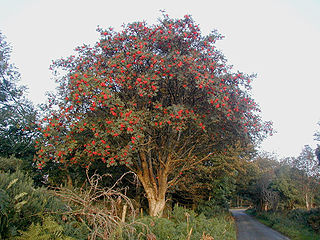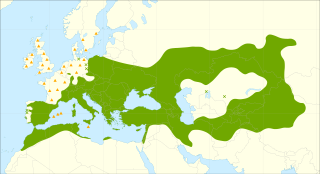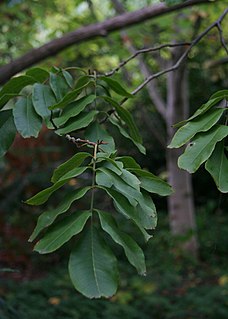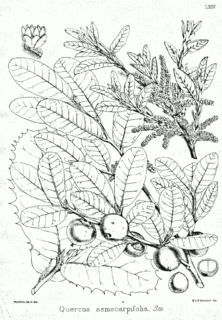
Quercus cerris, the Turkey oak or Austrian oak, is an oak native to south-eastern Europe and Asia Minor. It is the type species of Quercus sect. Cerris, a section of the genus characterised by shoot buds surrounded by soft bristles, bristle-tipped leaf lobes, and acorns that usually mature in 18 months.

Sorbus aucuparia, commonly called rowan and mountain-ash, is a species of deciduous tree or shrub in the rose family. It is a highly variable species, and botanists have used different definitions of the species to include or exclude trees native to certain areas; a recent definition includes trees native to most of Europe and parts of Asia, as well as northern Africa. The range extends from Madeira, the British Isles and Iceland to Russia and northern China. Unlike many plants with similar distributions, it is not native to Japan.

Tilia platyphyllos, the large-leaved lime or large-leaved linden, is a species of flowering plant in the family Malvaceae (Tiliaceae). It is a deciduous tree, native to much of Europe, including locally in southwestern Great Britain, growing on lime-rich soils. The common names largeleaf linden and large-leaved linden are in standard use throughout the English-speaking world except in the British Isles, where it is known as large-leaved lime. The name "lime", possibly a corruption of "line" originally from "lind", has been in use for centuries and also attaches to other species of Tilia. It is not, however, closely related to the lime fruit tree, a species of citrus.

Pinus canariensis, the Canary Island pine, is a species of gymnosperm in the conifer family Pinaceae. It is a large, evergreen tree native and endemic to the outer Canary Islands in the Atlantic Ocean. It is a subtropical pine and does not tolerate low temperatures or hard frost, surviving temperatures down to about −6 to −10 °C. Within its natural area, it grows under extremely variable rainfall regimes, from less than 300 mm (12 in) to several thousands, mostly due to differences in mist-capturing by the foliage. Under warm conditions, this is one of the most drought-tolerant pines, living even with less than 200 mm (7.9 in) of rainfall per year. It is the vegetable symbol of the island of La Palma.

Abies nordmanniana, the Nordmann fir or Caucasian fir, is a fir indigenous to the mountains south and east of the Black Sea, in Turkey, Georgia and the Russian Caucasus. It occurs at altitudes of 900–2,200 m on mountains with precipitation of over 1,000 mm.

Pterocarya, often called wingnuts in English, are trees in the walnut family Juglandaceae. They are native to Asia. The botanic name is from Ancient Greek πτερον (pteron) "wing" + κάρυον (karyon) "nut".

Populus alba, commonly called silver poplar, silverleaf poplar, or white poplar, is a species of poplar, most closely related to the aspens. It is native to Morocco and then Portugal through central Europe to central Asia. It grows in moist sites, often by watersides, in regions with hot summers and cold to mild winters.

Quercus trojana, the Macedonian oak is an oak in the 'turkey oak section' (Quercus sect. Cerris).

Corylus colurna, the Turkish hazel or Turkish filbert, is a deciduous tree native to southeast Europe and southwest Asia, from the Balkans through northern Turkey to northern Iran. It is also found growing wild in the forests of Western Himalayan range in the north Indian state of Himachal Pradesh particularly in the temperate regions of districts of Kullu, Shimla, Kinnaur district and Chamba district.

Fagus orientalis, commonly known as the Oriental beech, is a deciduous tree in the beech family Fagaceae. It is native to Eurasia, in Eastern Europe and Western Asia.

Magnolia sprengeri, or Sprenger's magnolia, is a species of Magnolia native to China, occurring in Gansu, Henan, Hubei, Hunan, Shaanxi, and Sichuan in forests or thickets at 1300–2400 m altitude. Named for Carl Ludwig Sprenger, a botanist of note.

Astronium is a genus of flowering plants in the cashew family, Anacardiaceae. It is native to Central and South America.

Populus tremula, commonly called aspen, common aspen, Eurasian aspen, European aspen, or quaking aspen, is a species of poplar native to cool temperate regions of Europe and Asia, from Iceland and the British Isles east to Kamchatka, north to inside the Arctic Circle in Scandinavia and northern Russia, and south to central Spain, Turkey, the Tian Shan, North Korea, and northern Japan. It also occurs at one site in northwest Africa in Algeria. In the south of its range, it occurs at high altitudes in mountains.

Persea indica is a species of plant in the family Lauraceae. It belongs to the evergreen tree genus Persea of about 150 species, of which the avocado, P. americana, is the best known.

Cyclocarya is a genus of flowering plants in the family Juglandaceae, comprising a single species Cyclocarya paliurus, formerly treated in the genus Pterocarya as Pterocarya paliurus. It is native to eastern and central China.

Pterocarya stenoptera is a small-winged wingnut tree of the Juglandaceae family. It is originally from Southeast China.

Alnus alnobetula is a common tree widespread across much of Europe, Asia, and North America. Many sources refer to it as Alnus viridis, the green alder, but botanically this is considered an illegitimate name synonymous with Alnus alnobetula subsp. fruticosa.

Quercus semecarpifolia is an Asian species of trees in the beech family. It is native to the Himalayas and nearby mountains in Tibet, Afghanistan, India, Nepal, and Pakistan.

Quercus hartwissiana, the Strandzha oak, is a species of oak, native to southeastern Bulgaria, northern Asia Minor along the Black Sea, and the Caucasus. It was described by the Finnish-born Russian botanist and entomologist Christian von Steven in 1857.
This fossil flora in Turkey stems from at least six Pliocene deposits in Güvem and Beşkonak villages, 80 kilometres (50 mi) north of Ankara, 22 kilometres (14 mi) north of Kızılcahamam and 125 kilometres (78 mi) south of the Black Sea coast. They are 1,000 metres (3,300 ft) to 1,500 metres (4,900 ft) above sea level, extending 15 kilometres (9.3 mi) north-south and 7 kilometres (4.3 mi) east-west. Between six and seven million years ago, a fresh water lake existed there in a forested area with mostly broad leaved deciduous tree species, dominated by sequoia and oak.





















